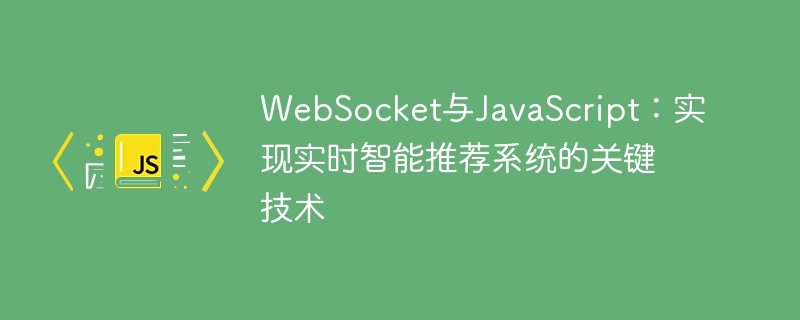

WebSocket and JavaScript: Key technologies for realizing real-time intelligent recommendation systems
Introduction:
With the rapid development of the Internet, intelligent recommendation systems play an important role in various fields. important role. In this article, we will discuss the key technologies for implementing a real-time intelligent recommendation system using WebSocket and JavaScript. WebSocket is a technology that establishes two-way communication between a web browser and a web server, while JavaScript is a scripting language used to write dynamic interactions on web pages. By combining WebSocket and JavaScript, we can achieve real-time data transmission and update of recommendation results, thereby providing a more accurate and personalized recommendation experience.
1. The principles and characteristics of WebSocket
WebSocket is a new communication protocol in HTML5, which allows two-way communication on the same TCP connection. Compared with the traditional HTTP protocol, WebSocket has the following characteristics:
1. Low latency: WebSocket uses full-duplex communication, which can push data from the server to the client in real time, reducing communication delay.
2. Efficiency: WebSocket uses binary frames to transmit data, which can reduce the amount of data transmission compared to the traditional HTTP protocol.
3. Persistent connection: Once the WebSocket connection is established, it will remain open, avoiding the consumption of frequent HTTP handshakes and closing the connection.
4. Cross-platform: WebSocket can run on a variety of browsers and also supports multiple programming languages on the server side.
2. JavaScript implements the basic operations of WebSocket
In JavaScript, communication with the server can be achieved through the WebSocket object. The following is an example of a simple WebSocket connection:
var socket = new WebSocket("ws://example.com/recommend"); socket.onopen = function() { console.log("WebSocket连接已建立"); }; socket.onmessage = function(event) { var data = JSON.parse(event.data); // 处理服务器推送的数据 }; socket.onclose = function(event) { console.log("WebSocket连接已关闭"); }; socket.onerror = function(error) { console.log("WebSocket连接发生错误"); }; function sendRequest(data) { socket.send(JSON.stringify(data)); }
In the above code, we first create a WebSocket object and specify the address of the server. Then, the interaction with the server is handled by defining a series of event handling functions. Among them, theonopenevent is triggered when the WebSocket connection is established, theonmessageevent is triggered when the data pushed by the server is received, and theoncloseevent is triggered when the WebSocket connection is closed.onerrorThe event is triggered when an error occurs. Finally, thesendRequestfunction is used to send a request to the server.
3. Workflow of real-time intelligent recommendation system
Real-time intelligent recommendation system generally consists of the following components: user data collection, recommendation algorithm, recommendation result storage and WebSocket communication. The workflow of the system is as follows:
1. User data collection: The system establishes user portraits by collecting user behavioral data, such as browsing records, purchase records, etc.
2. Recommendation algorithm: Based on user portraits and other information, the system uses recommendation algorithms to calculate personalized recommendation results for users.
3. Recommended result storage: The system stores the recommended results in the database or cache, waiting for WebSocket to be sent to the client.
4.WebSocket communication: The client and the server establish a two-way communication channel through WebSocket. The client can send a request to the server, and the server pushes the recommendation results to the client through WebSocket.
5. Display recommended results: After the client receives the recommended results, it will be displayed to the user.
4. Use WebSocket to update the recommendation results in real time
The following is a sample code that uses WebSocket to update the recommendation results in real time:
var socket = new WebSocket("ws://example.com/recommend"); socket.onmessage = function(event) { var data = JSON.parse(event.data); // 更新推荐结果 updateRecommendation(data); }; function updateRecommendation(data) { // 更新推荐结果的展示 var recommendationContainer = document.getElementById("recommendation-container"); recommendationContainer.innerHTML = ""; for (var i = 0; i < data.length; i++) { var recommendationItem = document.createElement("div"); recommendationItem.innerHTML = data[i].title; recommendationContainer.appendChild(recommendationItem); } }
In the above code, we listen to the information sent by the server through WebSocket data. Once the recommendation results are received, theupdateRecommendationfunction will be called to update the display of recommended results on the page. In theupdateRecommendationfunction, we first clear the container of recommended results, and then generate and display recommended items based on the received data.
Conclusion:
By combining WebSocket and JavaScript, we can realize the key technologies of real-time intelligent recommendation system, thereby providing a more accurate and personalized recommendation experience. This article introduces the principles and characteristics of WebSocket, JavaScript implements the basic operations of WebSocket, and gives a code example for using WebSocket to update recommended results in real time. I hope this article can be helpful to the development of real-time intelligent recommendation systems.
The above is the detailed content of WebSocket and JavaScript: key technologies for implementing real-time intelligent recommendation systems. For more information, please follow other related articles on the PHP Chinese website!
